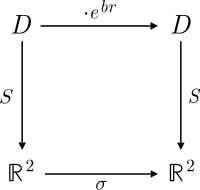There are three binarion AC algebras. The division binarions C is the field of complex numbers:
Several academic journals and many university texts are dedicated to the function theory of C, for example the Wikibook Complex Analysis.
As mentioned in the Introduction, C can be taken as unarion AC algebra with * just the identity map. The binarions from this unarion field are bicomplex numbers. For example,
Then Sir James Cockle wrote about tessarines in 1848, describing features of this AC algebra to be denoted T. For instance, there is the element
The third binarion AC algebra is This real plane in T is called the split-complex numbers, or split binarions, in the AC algebra context, but has found many applications and other labels.
Usually hi is written j so the generic split complex number is Then in D, so that when N(z) is constant z is on a hyperbola. Hence the necessity of the Transcendental paradigm in the description of this AC algebra.
Division binarions
With is the square of the Euclidean distance from 0 to z. Furthermore, the vectors from 0 to w and z in C are perpendicular, z ⊥ w, when These features make C an ideal vehicle for geometric display.
As an example, consider the perpendicularity of the diagonals of a rhombus One diagonal is z + w and the other is parallel to z – w. They are perpendicular because
- .
Split binarions
Given that j2 = +1, it follows that jn is one (1) when n is even, and equals j when n is odd. Therefore
- as the powers of j separate the even and odd terms.
The variable a is a hyperbolic angle along a unit hyperbola This configuration is a normalized form of the natural hyperbola, where now the multiplicative identity is a unit distance from the origin, so sector areas are half the angle sizes due to the normalization.
Instead of squeeze mappings preserving areas in sectors of the natural hyperbola, the multiplication in D does the squeezing. The re-linearization of velocity addition in special relativity uses the parametrization of the unit hyperbola in D. Indeed, if two rapidities a and b are added, the result is their sum according to in D.
The notion of orthogonality in D is arithmetically consistent with the condition in C, but expresses instead hyperbolic orthogonality, the relation of a worldline to its simultaneous hyperplane. Though only two-dimensional, the split binarions contribute to understanding special relativity.
Topology in D differs considerably from that in C. The diagonals y = ± x have N = 0 and they correspond to the locus of null vectors. Points not on the diagonal have a polar decomposition:
The factor k is in a four group and flips the identity component into the other three quadrants. Note that (a, p) is in the upper half-plane since p > 0.
Exercises

1. Matrix and σ is a squeeze mapping on R2. Show that the matrix S provides a mapping that makes D and (R2, xy) isomorphic as rings and quadratic spaces, but that S is not an isometry on the real plane with Euclidean metric.
2. Show
3. For u in the group of units U, a ⊥ b implies ua ⊥ ub .
4. For S ⊂ D, area(S) finite, u ∈ U, show area {ua : a ∈ S } = area(S).
5. What does the hyperbolic angle have in common with the harmonic series Answer: no bound. Compare their geometry.
6. Draw the subgroup
Complex binarions
The procedure for complex binarions replaces R with C in the construction of real binarions, except that C is deprived of complex conjugation, the conjugation being replaced by the identity mapping. The result of the construction is an algebra of two complex dimensions, (z,w), with conjugation (z,w)* = (z, − w), and The algebra has null vectors and is a split AC algebra. Note in particular that (0,1)(0,1) = (−1,0) so that (0,1) is an imaginary unit.
The idea of an algebra with two imaginary units that commute was considered in mid-19th century Britain. Hamilton used a commuting h with his biquaternions. James Cockle saw that the square of the product of these imaginary units was plus one, thus creating "a new imaginary in algebra" as he wrote in Philosophical Magazine in 1848. His use of the letter j, j2 = +1, has been widely adopted. Although Hamilton provided a vocabulary of vector operations (including the del operator), these explorations preceded set theory, group theory, and the unfolding of mathematical notation. With 1 on the real axis, the two imaginary units, and their product, Cockle's commutative algebra T (tessarines) has a real basis of four elements. By the end of the 19th century tessarines and quaternions were referred to as hypercomplex numbers.
In 1892 Corrado Segre introduced bicomplex number in Mathematische Annalen (v 40: 455 to 67). In 1919 Leonard Dickson explained the development of composition algebras. He was working on the step from division quaternions to octonions (beyond the scope of this text). In 1942 A. A. Albert regularized the science of composition algebras over R and C. Though complex binarions are naturally a complex algebra, the temptation to view it as a real algebra reveals the split binarion plane. Nevertheless, the complex number basis of the algebra is essential to the construction of biquaternions in the next chapter.